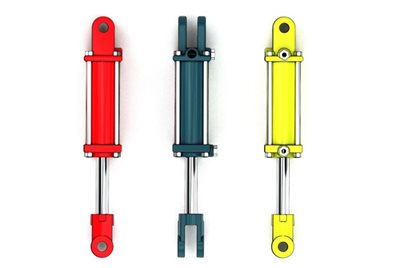How to Calculate Hydraulic Pressure
.jpg?width=399&height=266)
Hydraulic pressure is a fundamental concept in fluid mechanics and is crucial in various applications, such as hydraulic systems, machinery, and automotive engineering. Understanding how to calculate hydraulic pressure is essential for efficiently designing and maintaining these systems.
There are specific calculations you can perform when you want to find out what the most appropriate hydraulic system pressure is for a particular application. Before we discuss the formulas used to determine pressure, it is important to understand basic hydraulic concepts.
Basic Hydraulics
Hydraulic systems are widely used in various industries, ranging from construction and manufacturing to automotive and aerospace. Understanding the basic hydraulics is crucial for anyone working with or designing hydraulic systems.
At its core, hydraulics deals with the mechanical properties of fluids under pressure. Fluids, such as hydraulic fluid, oil, or water, transmit force when subjected to pressure and can exert immense power. This property forms the basis of hydraulic systems’ ability to generate substantial force through relatively small components.
The key components of a hydraulic system include a fluid reservoir, hydraulic pumps, motors, valves, actuators (such as cylinders or motors), and connecting pipes or hoses. The pump pressurises the fluid by converting mechanical energy into hydraulic energy. This pressurised fluid then flows through the system, controlled by valves, to direct and control the fluid ging to the actuators.
One fundamental principle in hydraulics is Pascal’s law: The pressure applied to an enclosed fluid is transmitted equally in all directions. This principle allows for force multiplication and precise control within hydraulic systems.
Hydraulic systems rely on mathematical calculations involving parameters such as pressure, flow rate, and area to determine their performance. Calculations of hydraulic pressure involve considering factors like pump output, cylinder size, and fluid properties.
Overall, understanding the basics of hydraulics is essential for designing efficient systems and troubleshooting any issues that may arise. By comprehending how fluids transmit force under pressure and calculating important parameters, one can optimise the performance and reliability of hydraulic systems.
It is also important to be aware of safety precautions when working with hydraulics, as high pressures and potential leaks can pose hazards. Having a solid foundation in hydraulic basics enables engineers, technicians, and operators to effectively harness the power of hydraulics for many applications and industries.
Calculating Hydraulic Pressure in the System
To calculate hydraulic pressure in a system, you need to consider various factors such as force, area, and fluid properties. Here is a step-by-step guide to help you calculate hydraulic pressure accurately:
- Determine the force required. Identify the forces required to act on an object or surface by the hydraulic system. This could be the force required by an actuator (e.g., hydraulic cylinder) to move or hold the load upon which the force is required to act.
- Calculate the effective area: Measure or determine the surface area on which the force is acting. This can be done by measuring the diameter of a cylinder or using geometric formulas for different shapes.
- Use Pascal’s Law: To calculate hydraulic pressure, apply Pascal’s Law, which states that pressure is equal in all points of a confined fluid. The formula is: Pressure = Force / Area
- Convert units if necessary: Ensure that the force and area are measured or expressed in consistent units (e.g., Newtons for force and square metres for area). If different units are used, convert them accordingly.
- Consider fluid properties: Depending on the specific hydraulic system, you may need to account for factors such as the viscosity of the hydraulic fluid or pressure losses due to friction within pipes or valves. Consult relevant equations or standards that factor in these considerations.
By following these steps and using the appropriate formulas, you can accurately calculate hydraulic pressure within your system. Remember safety precautions should be taken when working with high-pressure hydraulic systems to prevent accidents and ensure the system operates within its designed limits.
- TIP: There are online calculators available where you simply plug in the values to get the result.
How to Calculate Hydraulic Pressure Required for a New System

Calculating the hydraulic pressure required for a new system involves considering several factors, such as the desired force, cylinder size, and fluid properties, and using these steps:
- Identify the amount of force required to accomplish the intended task in your system. This could be lifting or moving an object, applying pressure, or performing any other application-specific requirement.
- Choose a suitable hydraulic cylinder or actuator that can generate the necessary force. Consider factors like piston diameter (or area), stroke length, and load conditions.
- Determine the effective surface area on which the force will be exerted. For a cylinder, this can be calculated using the formula: Area = π * (Diameter/2)^2, where Diameter is the internal diameter of the cylinder.
- Apply Pascal’s law to calculate the hydraulic pressure needed. Substitute the force and area values determined in steps 1 and 3 into the formula: Pressure = Force / Area.
- Consider any specific requirements or limitations for your application that may affect pressure calculations.
- Take into account the properties of the hydraulic fluid being used, such as viscosity and temperature. These properties can affect the system’s overall performance and pressure capabilities.
Getting Help Calculating Hydraulic Pressure
For assistance in determining potential hydraulic system pressure or help determining which pumps,motors,hydraulic cylinders, and parts you need to build a new system, please contact White House Products, Ltd. at +44 (0) 1475 742500 today.
Back to blog posts